General Information
Benchmark Instructional Guide
Connecting Benchmarks/Horizontal Alignment
Terms from the K-12 Glossary
- NA
Vertical Alignment
Previous Benchmarks
- This is the first grade level where students will explore time concepts.
Next Benchmarks
Purpose and Instructional Strategies
The purpose of this benchmark is for students to begin to formally tell and write time.- Instruction includes getting students familiar with an analog clock as to what the hour hand and minute hand are and how to tell time with both digital and analog clocks (MTR.2.1, MTR.5.1).
- Instruction includes providing opportunities for students to manipulate analog clocks and to discuss and work with time in context (MTR.5.1, MTR.7.1).
- Instruction connects partitioning clocks in half as a representation of half an hour.
- For example, half the clock represents half of an hour.
- Within this benchmark, it is not the expectation for students to round all given times to the hour or half-hour, rather all given times should be shown in hours and half-hours.
Common Misconceptions or Errors
- Students may confuse the minute hand with the hour hand or the hour hand with the minute hand.
- Students may get distracted by the second hand.
- Students may read half-hour, or 30 minutes past, as 6 minutes past the hour because they do not recognize how to count minutes. In this case, guide students to notice the individual tick marks on the analog clock and how that represents one minute so if they count each one when they get to the 6 they have counted 30 minutes.
- Students may be confused by the fact that the number 12 also plays the role of the number 0 depending on if looking at the hour hand or the minute hand. For hours, 12 represents 12 noon or 12 midnight, whereas for minutes 12 represents 0.
Strategies to Support Tiered Instruction
- Teacher provides a small clock in which the minute hand has been removed. Instruction includes identifying where the arrow on the hour hand is pointing, how that hour is read and what is happening to the hour hand as time passes. Student-friendly language about the time includes approximations such as:
- Example:
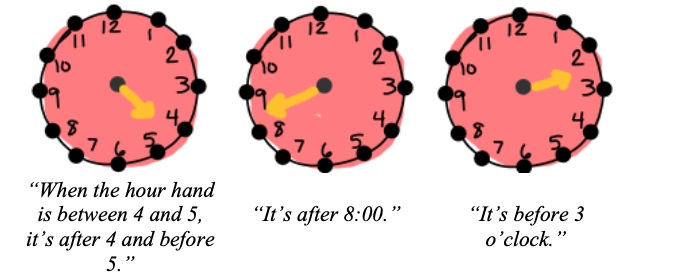
- Instruction includes making connections to the partitioning of a circle into two equal halves.
- For example, a clock can be partitioned into two equal halves by drawing a line or by folding the clock in half, noting the “shape” of half hours.
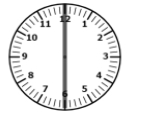
- Teacher provides instruction regarding how the numbers and tick marks on a clock can be thought of as a number line wrapped around a circle. Concepts to uncover on the number line include noticing that on the clock, the minute hands usually only show the count by 5’s and why, and that counting by 5’s or by ones using the tick marks will yield the same result when reading the clock to the half hour, or the 30-minute mark.
- For example, students can label a blank number line with numbers 0-59 and tape it in a circle so that 0 also serves as the 60.
Instructional Tasks
Instructional Task 1 (MTR.2.1)
- Part A. Look at each analog clock below, write the digital time for the clock.
- Part B. Sort analog and digital clock cards that show times for hour or half-hour by placing them on the correct side of the chart below.
- Part C. With a partner, compare your answers and explain how you know you put the time in the correct spot.
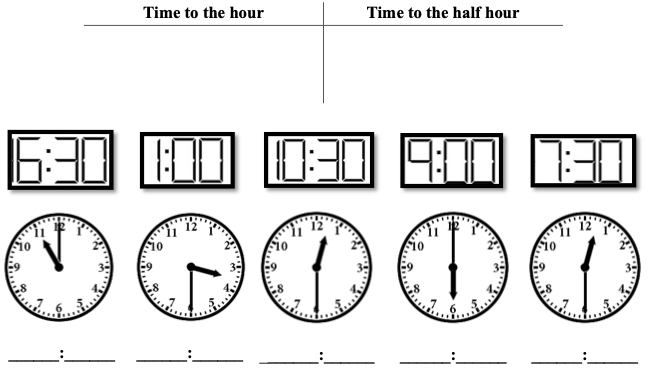
Instructional Task 2 (MTR.5.1)

- Part A. Use a blue crayon to color the clocks above that are partitioned into halves.
- Part B. Use a yellow crayon color the clocks above that are partitioned into fourths.
Instructional Items
Instructional Item 1
Match the digital clock with the analog clock that has the same time.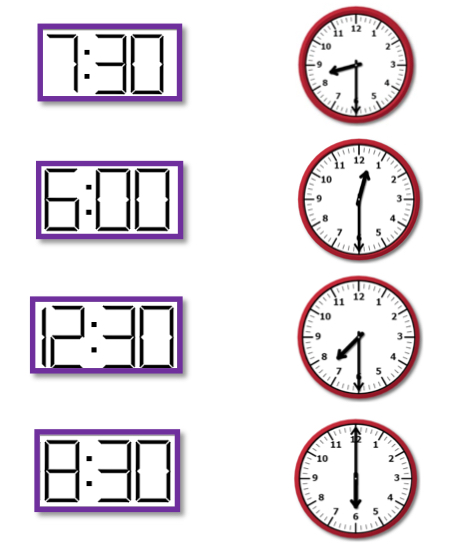
Instructional Item 2
- Part A. Robbie went to lunch at eleven-thirty. Show the time that Robbie went to lunch on the analog and digital clock below.

- Part B. What do you notice about the minute hand on the clock when thirty minutes have passed since 11 o’clock?
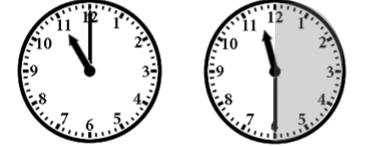
*The strategies, tasks and items included in the B1G-M are examples and should not be considered comprehensive.
